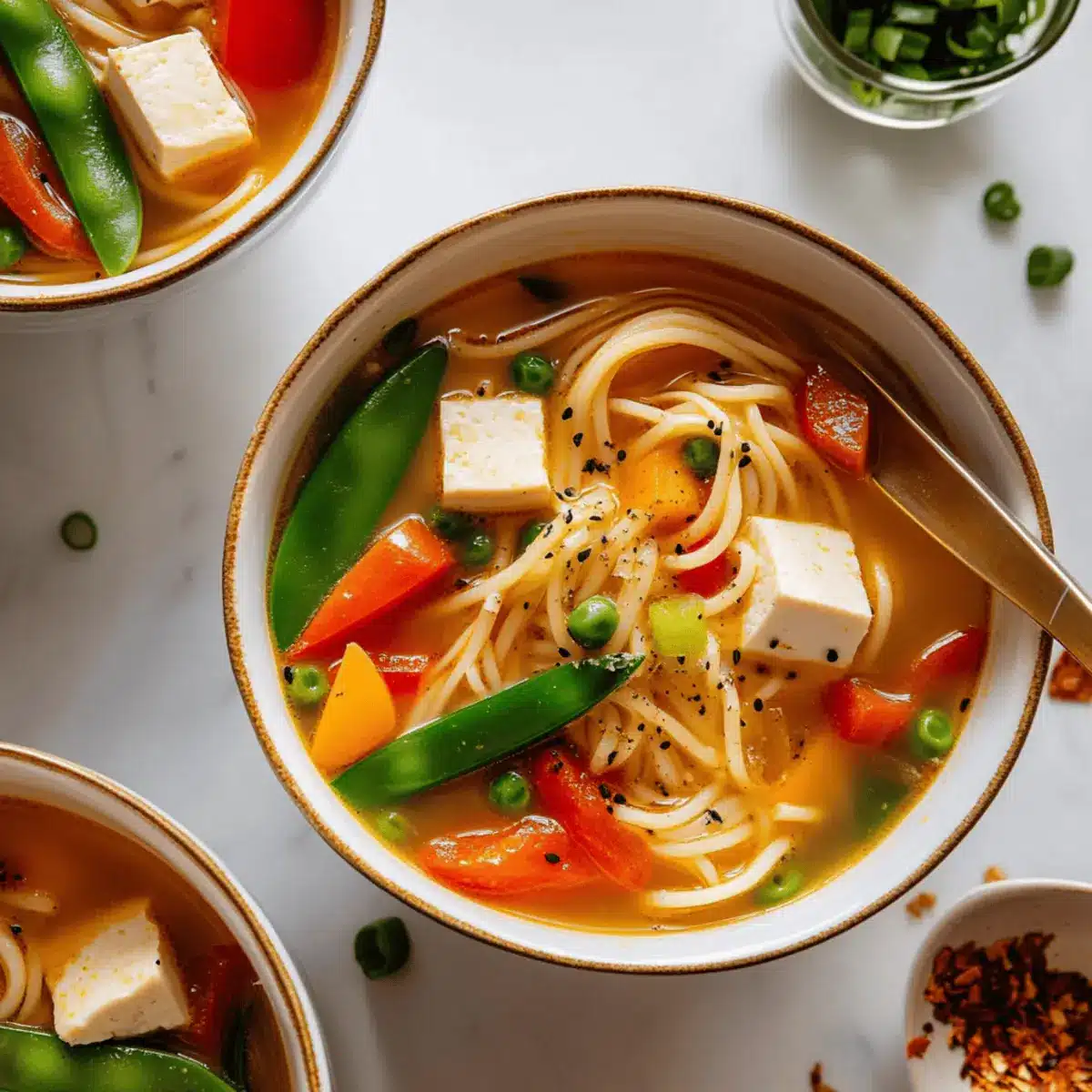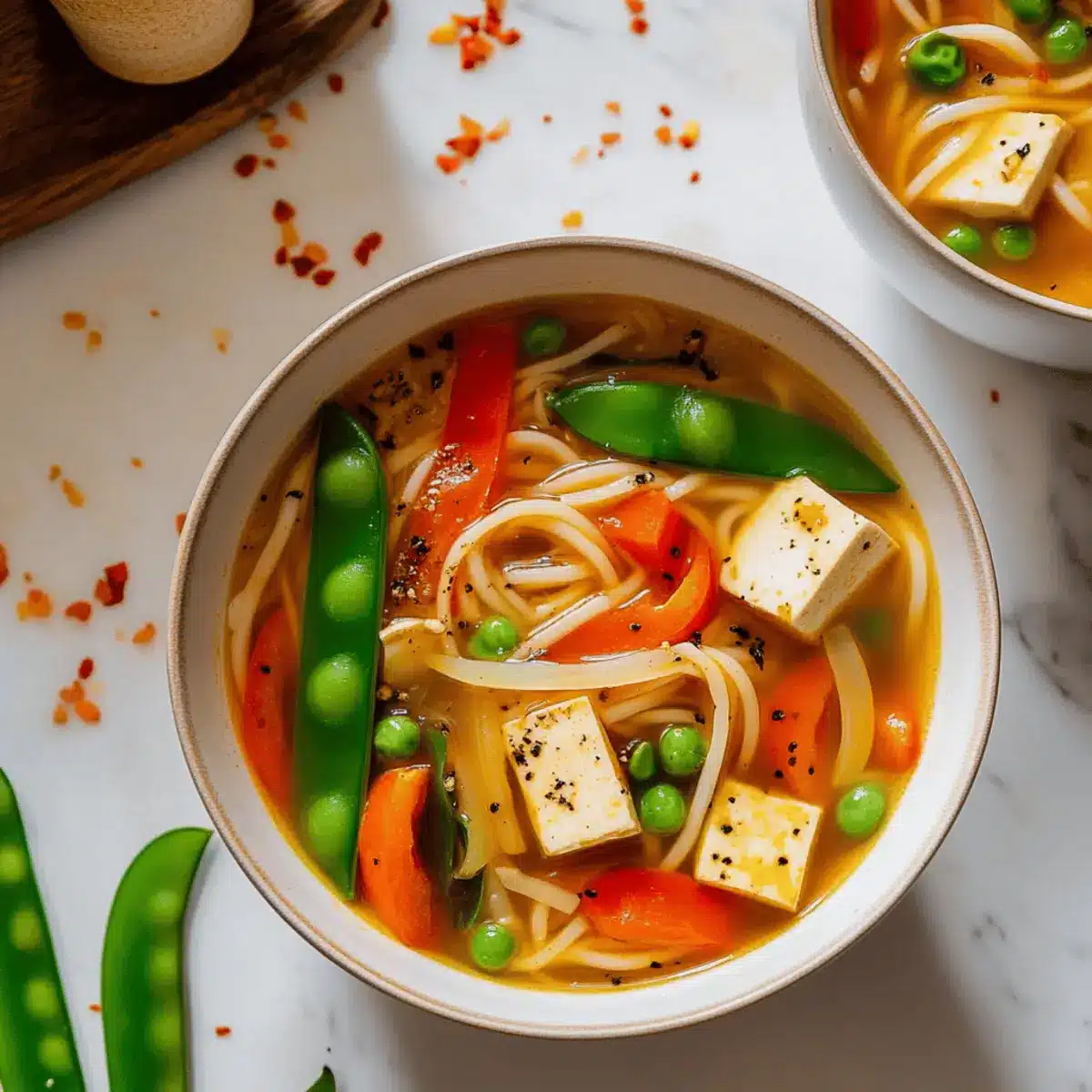As I stood in my kitchen, the comforting aroma of simmering broth wrapped around me like a warm hug. It’s moments like these when a bowl of Quick and Flavorful Miso Noodle Soup becomes the star of my dinner table. This vibrant soup is not only a delightful tribute to the beloved comfort food of yore but also brings a plant-based twist, making it perfect for those seeking a healthier option. With only 30 minutes from prep to plate, it’s an absolute lifesaver for busy weeknights or when you need a soothing dish to lift your spirits. Packed with hearty noodles, fresh vegetables, and protein-rich tofu, this recipe is gluten-free and dairy-free, inviting everyone to enjoy. So, what do you say—are you ready to craft your own bowl of cozy goodness?

Why is Miso Noodle Soup So Appealing?
Quick and Easy: Within just 30 minutes, you can whip up this hearty soup, making it an ideal choice for busy weeknights.
Vibrant Flavors: Packed with fresh veggies and umami-rich miso, this bowl bursts with delightful taste in every sip.
Customizable: Whether you prefer rice noodles or a medley of seasonal greens, this soup invites your creativity. Pair it with a light salad or a refreshing side of Seaweed Salad for a perfect meal!
Nutrient-Rich: Miso contributes essential probiotics, making this dish not only satisfying but also beneficial for gut health.
Comfort Food: With a texture reminiscent of ramen and a warm broth, this soup is your go-to for cozy nights in.
Miso Noodle Soup Ingredients
• Dive into this warming bowl with these simple yet essential ingredients for a heartwarming Miso Noodle Soup!
For the Broth
- Vegetable Broth – Provides the base of the soup with depth of flavor; opt for low-sodium for a healthier choice.
- Water – Balances the broth to create a lighter soup; adjust to your preferred thickness.
For the Noodles
- Spaghetti – Serves as the main carbohydrate; choose over soba noodles to avoid a gummy texture, or use gluten-free noodles for a suitable variation.
For the Protein
- Extra-firm Tofu – Delivers protein and texture; swap with tempeh if you crave a different flavor profile.
For the Vegetables
- Bell Peppers – Adds vibrant color and a hint of sweetness; feel free to substitute with zucchini or mushrooms for variety.
- Snow Peas – Provides a satisfying crunch; can be replaced with snap peas or omitted based on preference.
- Carrots – Brings sweetness and crunchy texture; try using ribbons for an elegant presentation.
For Flavoring
- Ginger – Infuses warmth and depth; adjust according to your taste.
- Green Onions – Offers freshness and beautiful garnish; substitute with chives if you’re out.
- Sesame Oil – Adds a nutty aroma; toasted sesame oil is highly recommended for maximum flavor.
- Tamari (or soy sauce) – Enhances umami notes; ensure gluten-free if required.
- Red Pepper Flakes (optional) – Spice lovers can add this for a kick; sriracha makes a great substitute or omit if not preferred.
Step‑by‑Step Instructions for Miso Noodle Soup
Step 1: Prepare the Broth
In a large saucepan, combine 4 cups of vegetable broth and 2 cups of water. Bring this mixture to a rolling boil over high heat, as the steam dances upward, filling your kitchen with its inviting aroma. This will serve as the flavorful base for your comforting Miso Noodle Soup.
Step 2: Cook the Spaghetti
Once the broth reaches a boil, add in 8 ounces of spaghetti, stirring occasionally to prevent sticking. Cook for about 3 minutes, or until the noodles are al dente and have a slight bite. The noodles should be tender yet firm, ready to absorb the delicious broth flavors as they mingle in the pot.
Step 3: Incorporate the Protein and Vegetables
Stir in 1 block of cubed extra-firm tofu, 1 cup of sliced bell peppers, and 2 chopped green onions along with 1 tablespoon of freshly grated ginger. Allow the soup to come back to a simmer and cook for an additional 3 minutes, letting the vegetables brighten and soften while the tofu warms through.
Step 4: Add Final Vegetables
Next, introduce 1 cup of snow peas and the ribboned carrots to the mix. Cook for just 1 minute, stirring gently until the snow peas are vibrant and the carrots are tender-crisp. This step infuses your Miso Noodle Soup with lovely colors and textures, inviting both your eyes and taste buds to partake.
Step 5: Mix in the Miso Paste
In a small bowl, scoop out a ladle of the hot broth and mix in 3 tablespoons of miso paste until smooth. Pour this back into the soup along with 1 tablespoon of toasted sesame oil and 2 tablespoons of tamari. Stir well to incorporate all the rich flavors, adjusting seasoning to suit your taste.
Step 6: Serve and Garnish
Finally, ladle the fragrant Miso Noodle Soup into bowls while it’s still steaming. For an added touch of heat, sprinkle with red pepper flakes or drizzle with sriracha, if desired. Each bowl should showcase a medley of colorful vegetables and hearty noodles, ready to deliver warmth and comfort.

Expert Tips for Miso Noodle Soup
- Prep Ahead: Have all your ingredients chopped and ready. This Miso Noodle Soup cooks quickly, and prepped ingredients make it seamless.
- Miso Mastery: Always dissolve miso in a small amount of hot broth before adding it to prevent clumping. This keeps your soup creamy and flavorful.
- Tofu Texture: Pan-fry the tofu before adding it to the soup for a firmer texture and improved flavor; it caramelizes beautifully!
- Noodle Options: Stick to spaghetti for the best texture, but if you’re gluten-free, use a noodle blend designed for soups to avoid gumminess.
- Season to Taste: Don’t forget to taste and adjust seasoning. Tamari can vary in saltiness, so start small and build the flavor up.
What to Serve With Miso Noodle Soup
Pairing your Miso Noodle Soup with complementary sides and flavors can elevate your dining experience, enhancing the warmth of your meal.
- Seaweed Salad: Light and refreshing, this salad adds a unique texture that balances the rich flavors of the soup.
- Vegetable Spring Rolls: Crisp and filled with fresh veggies, they create a delightful contrast alongside the warm soup.
- Edamame: Simple, lightly salted edamame offers a protein-packed snack that’s perfect for nibbling while enjoying the soup.
- Crusty Bread: A slice of warm, crusty bread is perfect for dipping into the broth, soaking up all those tasty flavors.
- Cucumber Salad: Cool and tangy, this salad provides a refreshing crunch that offsets the soup’s warmth.
- Herbal Tea: A cup of chamomile or ginger tea creates a cozy atmosphere, making your meal feel even more soothing.
- Fruit Sorbet: For dessert, a light sorbet is a delightful way to cleanse the palate after a hearty bowl of soup.
- Spicy Tofu Skewers: Grilled tofu marinated in a spicy sauce complements the miso with an added kick, enhancing the overall flavor profile.
- Pickled Vegetables: The tangy zing of pickled veggies invigorates your taste buds and adds complexity to the meal.
How to Store and Freeze Miso Noodle Soup
-
Fridge: Store any leftovers in an airtight container for up to 3 days. When ready to enjoy, reheat gently on the stove and add a splash of water if needed to loosen the broth.
-
Freezer: For longer storage, freeze the soup without noodles in a freezer-safe container for up to 2 months. When ready to eat, thaw in the fridge overnight and reheat on the stovetop, adding freshly cooked noodles.
-
Noodle Storage: If you have leftover noodles, keep them separate from the soup to prevent them from becoming mushy. Store in an airtight container in the fridge for up to 2 days.
-
Reheating Tips: For the best flavor and texture, always reheat Miso Noodle Soup slowly and ensure it’s heated thoroughly before serving.
Miso Noodle Soup Variations
Customize your bowl of Miso Noodle Soup with these delightful twists that will have your taste buds dancing!
-
Rice Noodles: Swap the spaghetti with rice noodles for a gluten-free alternative that adds a unique texture.
The delicate nature of rice noodles pairs beautifully with the rich broth, making each slurp enjoyable. -
Leafy Greens: Stir in a handful of spinach or bok choy for an extra nutrient boost and vibrant color.
These greens wilt quickly, adding freshness and a lovely contrast to the hearty noodles and tofu. -
Seasonal Veggies: Embrace seasonal produce by incorporating fresh asparagus in spring or roasted butternut squash in fall.
Seasonal veggies not only add flavor but also create a wonderful visual appeal in your soup. -
Coconut Lush: Add a splash of coconut milk for a creamy richness that complements the flavors wonderfully.
The coconut’s natural sweetness mellows the miso while giving your soup a tropical twist. -
Heat Lovers: Crank up the spice with sliced jalapeños or a generous spoonful of spicy miso paste.
The heat melds beautifully with the umami, giving each bite a zesty kick—a lovely contrast to the soothing broth. -
Herbal Infusion: Toss in fresh herbs such as cilantro or basil for a fragrant finish that brightens each bowl.
Herbs can elevate the soup’s flavor profile effortlessly, bringing a garden-fresh quality to your meal. -
Protein Play: Further boost protein content by adding edamame or chickpeas for a satisfying, hearty option.
This twist not only diversifies textures but also creates a lovely fusion of flavors in your comforting bowl. -
Umami Upgrade: Enhance the umami flavor with a few drops of mushroom soy sauce instead of tamari for a deeper taste.
This substitution introduces an earthy note, enriching the soup’s complexity and making it even more satisfying.
These variations will surely make you fall in love with your Miso Noodle Soup over and over again! For more delicious ideas, check out my recipes for Tomato Soup Cheddar and Flavorful Sweet Soup.
Make Ahead Options
These Miso Noodle Soup preparations are a game-changer for busy home cooks! You can chop your vegetables and cube the tofu up to 24 hours in advance and store them in airtight containers in the refrigerator to maintain their freshness. The broth can be prepared and stored separately for up to 3 days. Just reheat the broth when you’re ready to enjoy your soup. To finish, simply add your noodles and fresh ingredients to the hot broth, simmer for a few minutes, and mix in the miso paste right before serving. You’ll have a delicious, comforting soup with minimal effort, perfect for hectic weeknights!

Miso Noodle Soup Recipe FAQs
What type of vegetable broth should I use for Miso Noodle Soup?
I recommend using low-sodium vegetable broth to keep the flavors balanced and healthier. Look for a broth that’s rich and flavorful; it serves as the essential base for this delicious soup!
How should I store leftovers from Miso Noodle Soup?
Store any leftover soup in an airtight container in the fridge for up to 3 days. When ready to enjoy again, gently reheat it on the stove. You might want to add a splash of water during reheating to loosen the broth if it gets too thick.
Can Miso Noodle Soup be frozen?
Absolutely! For freezing, I suggest separating the noodles from the soup. Freeze the soup (without tofu) in a freezer-safe container for up to 2 months. To enjoy it later, thaw in the refrigerator overnight and reheat on the stove, adding freshly cooked noodles to keep them the right texture.
How can I make sure my noodles don’t become mushy?
To prevent mushy noodles, cook only the amount you plan to eat and store any leftovers in a separate airtight container in the fridge for up to 2 days. Reheat the soup first and then add the previously cooked noodles just before serving to maintain that delightful chew!
What if I have allergies to any ingredients in the Miso Noodle Soup?
If you have allergies, you can easily modify this recipe! Swap soy sauce for coconut aminos if you have a soy allergy, and for gluten-free, choose gluten-free noodles and tamari. Always check labels to ensure all ingredients fit your dietary needs.

Miso Noodle Soup: A Cozy Vegan Bowl in 30 Minutes
Ingredients
Equipment
Method
- In a large saucepan, combine 4 cups of vegetable broth and 2 cups of water. Bring to a rolling boil.
- Add in 8 ounces of spaghetti, stirring occasionally. Cook for about 3 minutes, until al dente.
- Stir in 1 block of cubed extra-firm tofu, 1 cup of sliced bell peppers, and 2 chopped green onions along with 1 tablespoon of freshly grated ginger. Simmer for an additional 3 minutes.
- Introduce 1 cup of snow peas and the ribboned carrots. Cook for just 1 minute until vibrant and tender-crisp.
- In a small bowl, mix 3 tablespoons of miso paste with a ladle of hot broth until smooth. Pour back into the soup with 1 tablespoon of toasted sesame oil and 2 tablespoons of tamari. Stir well.
- Ladle the soup into bowls and garnish with red pepper flakes or sriracha if desired.
